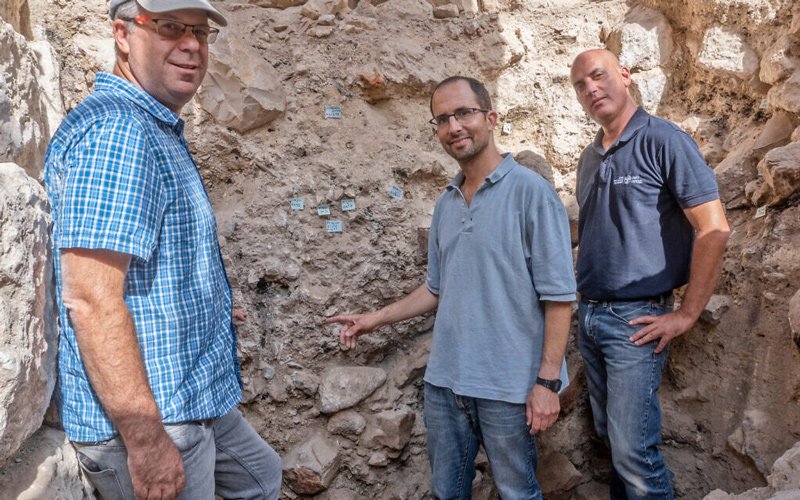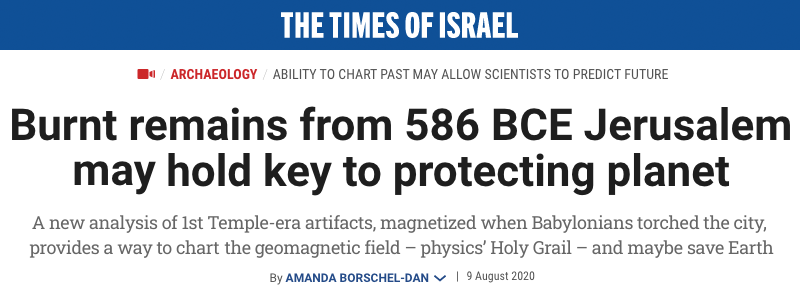
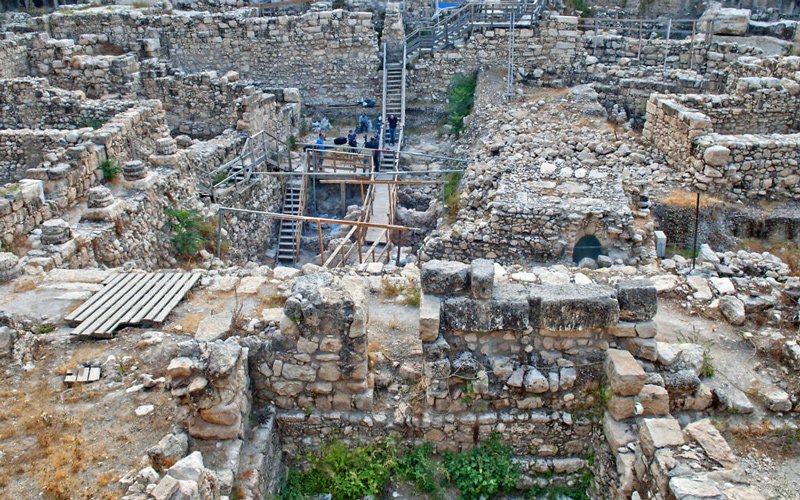
The Bible and pure science converge in a new archaeomagnetism study of a large public structure that was razed to the ground on Tisha B’Av 586 BCE during the Babylonian conquest of Jerusalem. The resulting data significantly boosts geophysicists’ ability to understand the “Holy Grail” of Earth sciences — Earth’s ever-changing magnetic field.
“The magnetic field is invisible, but it plays a critical role in the life of our planet. Without the geomagnetic field, nothing on Earth would be as it is — maybe life wouldn’t have evolved without it,” Hebrew University Prof. Ron Shaar, a co-author of the study, told The Times of Israel.
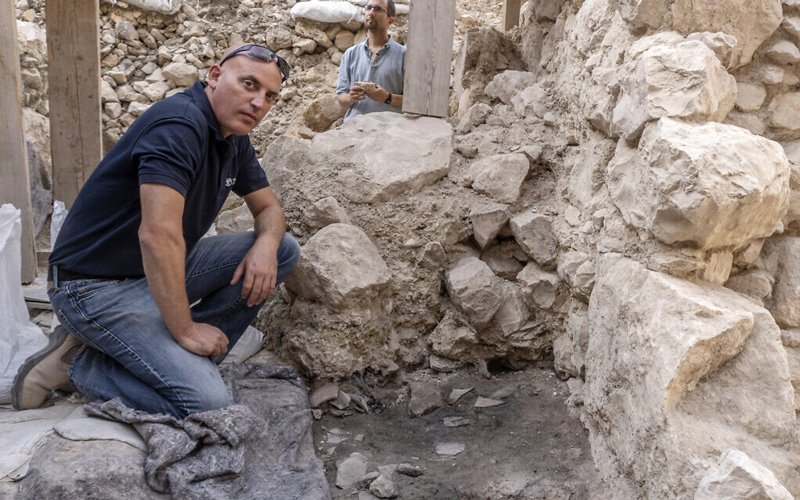
In the new study published in the PLOS One scientific journal, lead author and archaeologist Yoav Vaknin harvested data from pieces of floor from a large, two-story building excavated in the City of David’s Givati parking lot. Minerals embedded in the dozens of floor chunks were heated at a temperature higher than 932 degrees Fahrenheit (500 degrees Celsius) and magnetized during the slash and burning of ancient Jerusalem, and therefore offered up geomagnetic coordinates.
“No comparable floor from the Iron Age has ever been found in Jerusalem or other sites in the southern Levant,” says the PLOS One article.
The coordinates taken from the floor give a rare “peephole” of the Earth’s magnetic field during Tisha B’Av 586 BCE, said Tel Aviv University PhD student Vaknin.
“The floor of the structure is filled with magnetized minerals that absorbed the field that was on Earth at the time. Since the magnetic field changes all the time we’re trying to reconstruct it. Here, we have a little peephole, accurate to the day, of the ancient magnetic field from 2,600 years ago,” said Vaknin.
There is a general consensus among scholars that the arson and wanton destruction depicted in 2 Kings, 25, 8-9 took place on Tisha B’Av. “I don’t know of anyone who doubts the historicity of the event,” said Vaknin. However, even gaining “surety to the month, and even to the year is very rare” when speaking of events that took place 2,600 years ago, said Vaknin.
Archaeological findings such as pottery sherds, bricks, roof tiles and furnaces essentially record the Earth’s magnetic field as they are burned, according to a TAU press release. This is because the artifacts are constructed of magnetic minerals — such as calcite in the floor — that are re-magnetized in the high temperature to the direction and magnitude of the field when they were heated.
According to Vaknin, the importance of his study goes well beyond the ability to explain to archaeologists how to use another hi-tech technique that helps date the tricky First Temple period. Due to a plateau spanning from circa 800-400 BCE, otherwise reliable radiocarbon dating is less useful.
He said the techniques of archaeomagnetism allow scientists to measure burnt features or artifacts for magnetic intensity and direction and compare the results.
“For the past two years, I’ve been sampling destruction layers and other burnt materials. In addition, we’re sampling materials from excavations that took place in the past,” he said.
Knowing the dates for the Babylonian destruction allows archaeologists to more securely date other Iron Age artifacts.
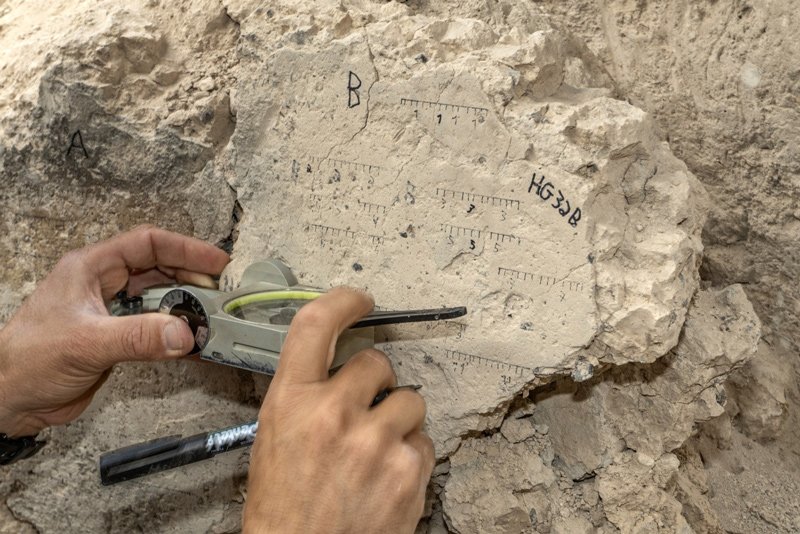
“The archaeomagnetic method has implications for future research. If we find a similar destruction layer with similar pottery at another site tomorrow, we will be able to compare the magnetic fields recorded at the two different sites, enabling us to determine whether the other site was also destroyed by the Babylonians,” said Vaknin.
But what is more important, he said, is that the gathered data allows physicists to use pinpointed coordinates to build more complete computer models of one of the most enigmatic subjects in physics, the magnetic field.
“Archaeology gives us an incident that we can date very, very accurately,” said Vaknin. “Archaeology gives us very accurate information on the time axis of when Jerusalem is burnt.” The physicists take over from there.
What is the geomagnetic field?
According to Hebrew University’s Shaar, a co-author on the study, “The magnetic field is generated by chaotic electrical and fluid currents at the Earth’s core. We geophysicists are trying to understand how it changes with the time, because it is constantly changing, and we are trying to understand why, and what are the mechanisms that drive the changes.”
According to a NASA website, “Every magnet produces an invisible area of influence around itself. When things made of metal or other magnets come close to this region of space, they feel a pull or a push from the magnet. Scientists call these invisible influences ‘fields.’”
If you’ve ever seen the experiment in which iron chip sprinkles on a piece of paper are sculpted by a magnet moved under a piece of paper, you’ve seen a magnetic field.

The study of the magnetic field has many reverberations outside pure physics and may be key in comprehending climate change: The magnetic field serves as Earth’s shield from cosmic radiation and charged particles from the sun. It is also used as a navigation tool by man — think compass — and by many birds and marine mammals who are naturally attuned.
Since the study of the magnetic field is still a relatively young discipline that began with Carl Friedrich Gauss in the 1830s, there is a data blackout from before scientists began charting its coordinates. The ability to gather geomagnetic coordinates from a specific date 2,600 years ago is exceptionally rare, said Shaar.
The ability to chart the past may allow scientists to predict the geomagnetic field’s future behaviors, which perhaps may help the future of humankind.

“The magnetic field of Earth actually changes its polarity over time. They are called Polarity Reversals, There have been about 170 of these reversals during the last 76 million years according to geological evidence,” writes NASA. Likewise, according to NASA, “Geophysicists have noted that the strength of Earth’s magnetic field has been decaying — about 5 percent globally over the past century. However, it is not changing in a uniform way; it grows, growing stronger in some places and weaker in others.”
A weaker shield is not considered positive, but scientists still don’t know enough to understand what it could mean, said Vaknin.
The archaeology behind the study
The interdisciplinary, interinstitutional study was published today in the prestigious PLOS One science journal. It is based on Vaknin’s doctoral thesis and was completed in collaboration with geophysicist Shaar and Tel Aviv University’s Prof. Erez Ben-Yosef, Prof. Oded Lipschits and Prof. Yuval Gadot, as well as Dr. Yiftach Shalev of the Israel Antiquities Authority. The City of David’s Givati Parking Lot excavation where the building is found is co-directed by Gadot and Shalev.
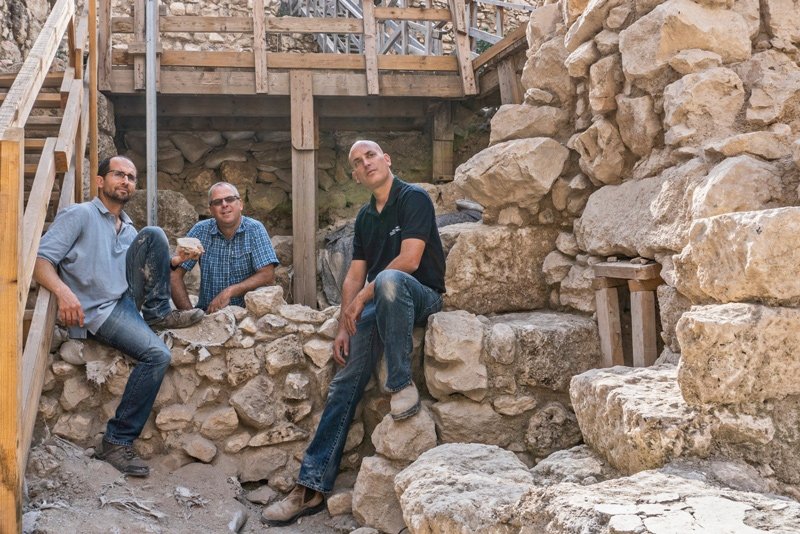
Gadot explained in a video accompanying a press release that the building under study was an impressive structure from the Kingdom of Judah. According to the article, the archaeologists uncovered a 17 meter by 10 meter (55 feet by 33 feet) segment of “a large structure that had served as an elite or public building.” The bottom story of the structure was filled with up to 2.3 meters (7.5 feet) of debris, including dirt and stones. “Among the debris a substantial amount of ash and charcoal was found, leading the excavators to the conclusion that the structure had been destroyed by an intense conflagration,” they write.
“What most surprised us were pieces of flooring. The floor should be under the destruction layer, but here we’re finding it mixed in,” Gadot said, adding that the flooring was of “exceptional quality.”
Co-excavator Yiftach said it was time to bring in the big guns. “It was clear that for this excavation we needed to go beyond the tools that we use in a regular excavation and use all the technology available to us and so we brought in Yoav, who used the techniques involved in paleomagnetism,” he said.
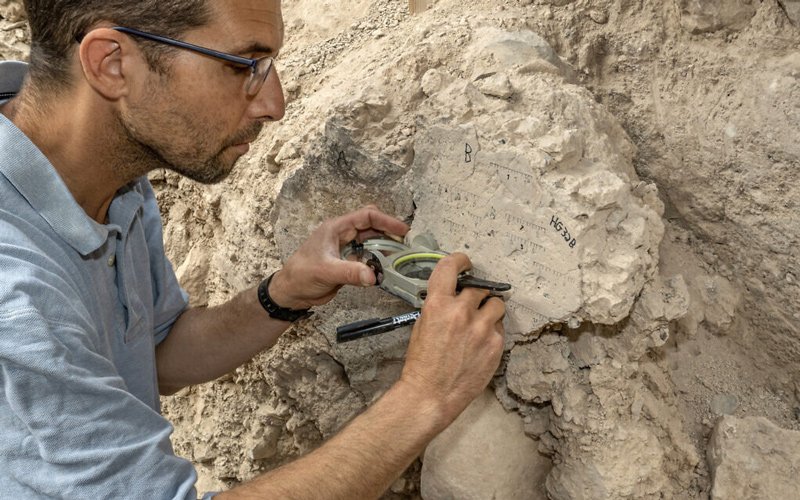
According to the article, Vaknin studied 54 pieces of “exquisitely crafted” floor that was 15 cm (6 inches) thick and had two layers. “The bottom layer was made of coarse material and pieces of limestone. The upper layer was made of consolidated well-sifted material and contained chunks of calcite, which probably shone when the floor was polished. Its upper face was perfectly flat and smooth.”
Vaknin conducted his paleomagnetic experiments at the magnetically shielded paleomagnetic laboratory at the Institute of Earth Sciences located at the Hebrew University of Jerusalem’s Givat Ram Campus where Shaar is based.
He writes in the article that in order to estimate the direction of the ancient magnetic field, the scientists averaged the directions of the 38 segments that yielded coordinates.
“Our results show that the acquisition of the magnetic information in the floor segments occurred during the destruction of the structure by fire. From this, in conjunction with the historically-based tight dating, we can conclude that we managed to pinpoint our paleomagnetic results on the time axis to less than a year, which is rare for such an early period,” write the authors.
Use of archaeomagnetism in Israel
When asked for comment on how common the use of archaeomagnetism is in Israeli excavations, Bar-Ilan Prof. Aren Maeir, the director of the Tell es-Safi/Gath Archaeological Project, wrote, “The method in recent years has been used extensively in Israel… We have used this at Safi as well.”
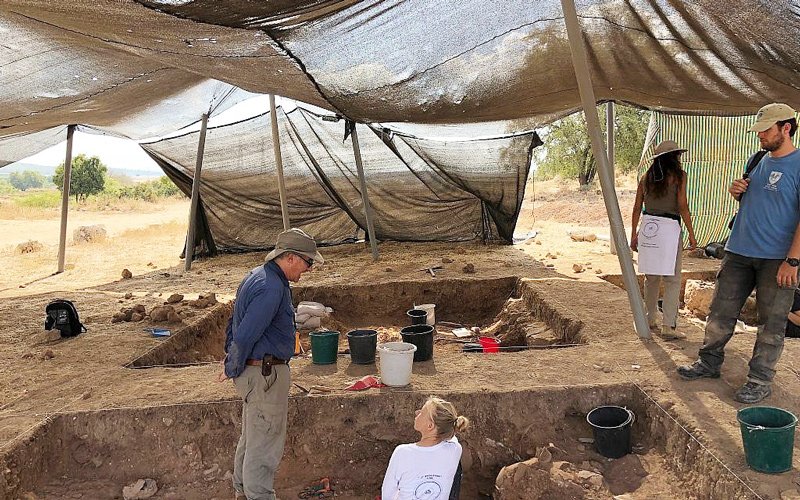
In fact, it was Shaar and some of his students who helped out at Safi.
“Dating ancient material is never an easy task, never,” said Shaar. He told The Times of Israel that he has been to dozens of excavation sites in recent years since developing a method to “read” pottery and other artifacts such as burnt structures and worked metals to gather more precious data points to chart the development of the geomagnetic field.
“We are sitting in Israel on a gold mine! It’s unbelievable,” said Shaar. “We have immediate access to an infinite number to artifacts we can measure and date and understand the field in the past.”
The geophysicists work in cooperation with archaeologists who provide them with archaeological material that can be dated and compared with other data points.
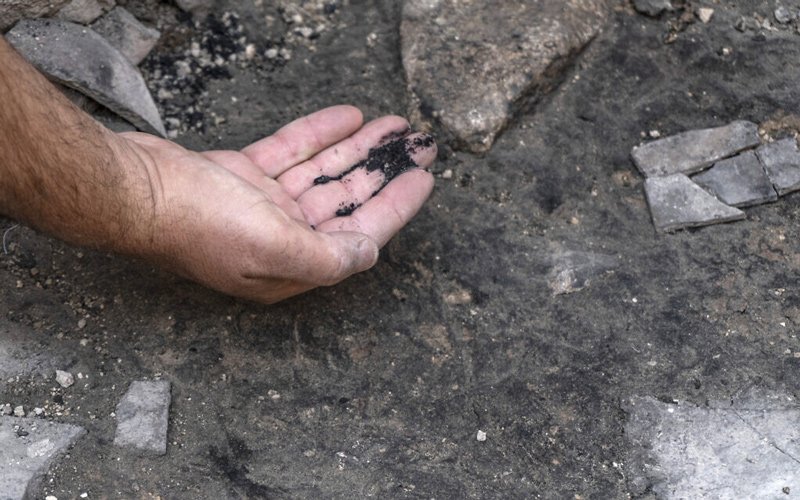
“Measuring magnetic data from a floor burned thousands of years ago is no trivial matter. We had to characterize the magnetic particles, understand how the magnetic data was coded in the material, and develop measuring techniques enabling us to read this data. Nature hasn’t made life easy for us,” said Shaar.
At the same time, Shaar is cautious about relying on one method to firmly date an artifact or an event. “Fortunately, in this particular study, Yoav was able to decipher nature’s magnetic code and give us important information from several angles: historic, archeological and geomagnetic,” he said.
